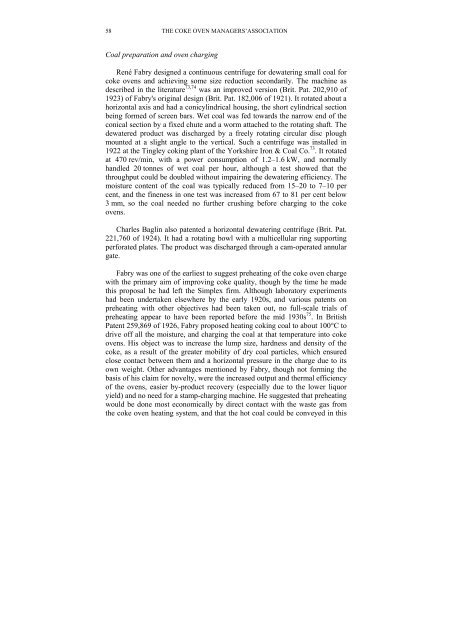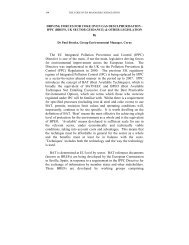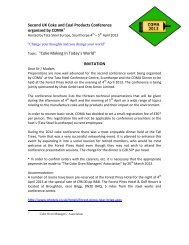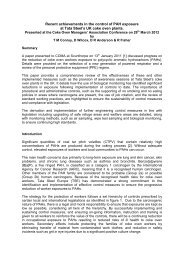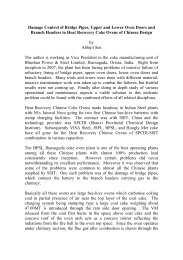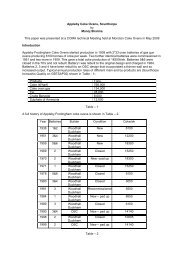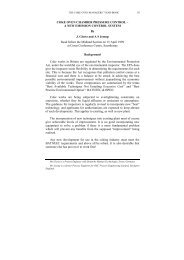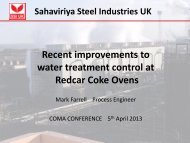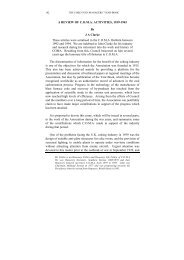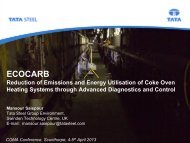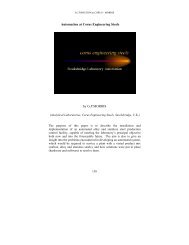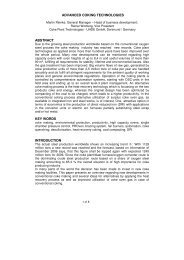CHAIRMAN'S ADDRESS - Coke Oven Managers Association
CHAIRMAN'S ADDRESS - Coke Oven Managers Association
CHAIRMAN'S ADDRESS - Coke Oven Managers Association
- No tags were found...
Create successful ePaper yourself
Turn your PDF publications into a flip-book with our unique Google optimized e-Paper software.
58 THE COKE OVEN MANAGERS’ASSOCIATIONCoal preparation and oven chargingRené Fabry designed a continuous centrifuge for dewatering small coal forcoke ovens and achieving some size reduction secondarily. The machine asdescribed in the literature 73,74 was an improved version (Brit. Pat. 202,910 of1923) of Fabry's original design (Brit. Pat. 182,006 of 1921). It rotated about ahorizontal axis and had a conicylindrical housing, the short cylindrical sectionbeing formed of screen bars. Wet coal was fed towards the narrow end of theconical section by a fixed chute and a worm attached to the rotating shaft. Thedewatered product was discharged by a freely rotating circular disc ploughmounted at a slight angle to the vertical. Such a centrifuge was installed in1922 at the Tingley coking plant of the Yorkshire Iron & Coal Co. 73 . It rotatedat 470 rev/min, with a power consumption of 1.2–1.6 kW, and normallyhandled 20 tonnes of wet coal per hour, although a test showed that thethroughput could be doubled without impairing the dewatering efficiency. Themoisture content of the coal was typically reduced from 15–20 to 7–10 percent, and the fineness in one test was increased from 67 to 81 per cent below3 mm, so the coal needed no further crushing before charging to the cokeovens.Charles Baglin also patented a horizontal dewatering centrifuge (Brit. Pat.221,760 of 1924). It had a rotating bowl with a multicellular ring supportingperforated plates. The product was discharged through a cam-operated annulargate.Fabry was one of the earliest to suggest preheating of the coke oven chargewith the primary aim of improving coke quality, though by the time he madethis proposal he had left the Simplex firm. Although laboratory experimentshad been undertaken elsewhere by the early 1920s, and various patents onpreheating with other objectives had been taken out, no full-scale trials ofpreheating appear to have been reported before the mid 1930s 75 . In BritishPatent 259,869 of 1926, Fabry proposed heating coking coal to about 100°C todrive off all the moisture, and charging the coal at that temperature into cokeovens. His object was to increase the lump size, hardness and density of thecoke, as a result of the greater mobility of dry coal particles, which ensuredclose contact between them and a horizontal pressure in the charge due to itsown weight. Other advantages mentioned by Fabry, though not forming thebasis of his claim for novelty, were the increased output and thermal efficiencyof the ovens, easier by-product recovery (especially due to the lower liquoryield) and no need for a stamp-charging machine. He suggested that preheatingwould be done most economically by direct contact with the waste gas fromthe coke oven heating system, and that the hot coal could be conveyed in this


